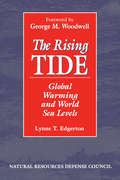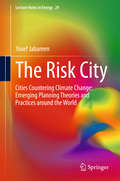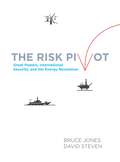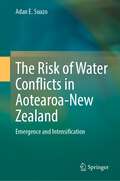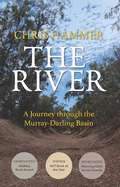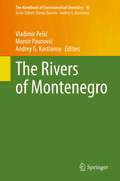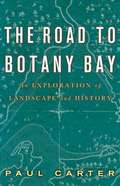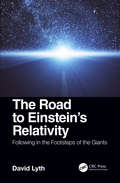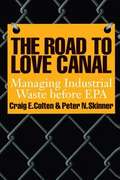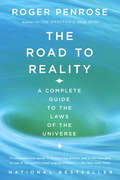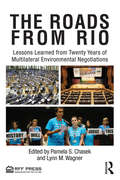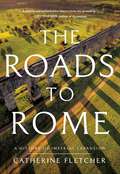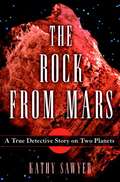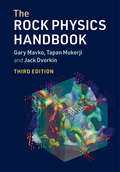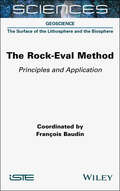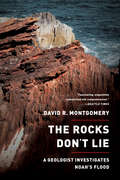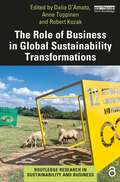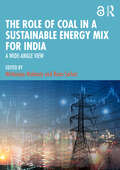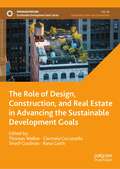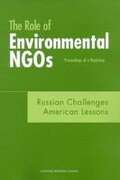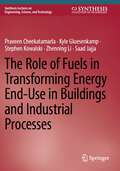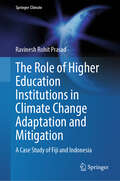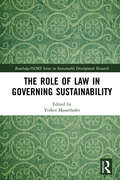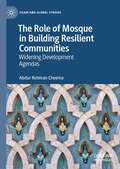- Table View
- List View
The Rising Tide: Global Warming And World Sea Levels
by Lynne EdgertonThe Rising Tide is the first analysis of global warming and world sea level rise. It outlines state, national, and international actions to respond to the effects of global warming on coastal communities and ecosystems.
The Risk City
by Yosef JabareenContemporary cities face phenomenal risks, and they face particularly high levels of mounting social and environmental risks, including social polarization, urban conflicts, riots, terror, and climate change threats. This book suggests that climate change and its resulting uncertainties challenge the concepts, procedures, and scope of conventional approaches to planning, creating a need to rethink and revise current planning methods. Therefore, this book suggests a paradigm shift in our thinking, interrogation, and planning of our cities. Based on the contemporary conditions of risk at cities, this book conceptualizes the risk city as a construct of three interlinked concepts of risk, trust, and practice. It is a construct of risk and its new evolving conditions and knowledge of uncertainties stem from climate change and other risks and uncertainties. As a construct of practices, the risk city produces social and political institutional framework and promotes practices accordingly in order to reduce risk and risk possibilities and to increase trust. In light of the complex challenges and risks to the human habitat that have emerged in recent years, many cities have prepared various types of plans aimed at addressing the challenges posed by climate change. Nonetheless, despite the importance of these plans and the major public resources invested in their formulation, we still know little about them and have yet to begin studying them and assessing their contributions . From the innovative perspective of the risk city, this book asks critical questions about the nature, vision, practices, and potential impact of the recent climate change-oriented plans. What kinds of risks do they attempt to address, what types of practices do they institute, and what types of approaches do they apply? Do they adequately address the risks and uncertainties posed? How do they contribute to the worldwide effort to reduce greenhouse gas emissions? This book uses the methodologically innovative Risk City framework to examine the nature, vision, outcomes, practices, and impact of these crucial plans, as well as their contribution to the resilience of our cities and to global efforts toward reducing greenhouse gas emissions.
The Risk Pivot
by Bruce D. Jones David StevenThe last decade has seen a revolution in global energy. First, we saw explosive growth in demand from Asia's rising powers, which fueled fears about scarcity and conflict. But we've also seen an American revolution in technology and markets, resulting in a dramatic increase in sup-ply. This is strengthening America's hand in the world--but it's not without complications. There are major security consequences of these shifts. Among the most consequential are China and India, Asia's emerging giants, which are increasingly exposed to political risks associated with energy risks, as well as the energy flows, pivoting to Asia. Meanwhile the great powers struggle to balance their need for fossil fuels with a mounting effort to tackle climate change. The top powers, and the United States above all, face a stra-tegic choice: whether to use energy as a weapon of geopolitics, or as a tool of a stable order.CONTENTS Introduction1. The President and the King--Key Messages of the Book2. The Energy Revolutions--A PrimerGeopolitics in Flux--The Players3. Choices--Scenarios, and the Choice the Powers Confront4. Rough Seas Ahead--The Great Powers' Search for Energy SecurityGlobalization and Complexity--The Problems5. Transition in the Gulf6. The Turbulent Middle7. Fragile States8. The Russian Problem9. Connections--from Pipelines to PoliticsGovernance--The Partners10. An Emerging System of Global Energy Governance11. Leadership Choices
The Risk Pivot
by Bruce D. Jones David StevenThe last decade has seen a revolution in global energy. First, we saw explosive growth in demand from Asia's rising powers, which fueled fears about scarcity and conflict. But we've also seen an American revolution in technology and markets, resulting in a dramatic increase in sup-ply. This is strengthening America's hand in the world-but it's not without complications. There are major security consequences of these shifts. Among the most consequential are China and India, Asia's emerging giants, which are increasingly exposed to political risks associated with energy risks, as well as the energy flows, pivoting to Asia. Meanwhile the great powers struggle to balance their need for fossil fuels with a mounting effort to tackle climate change. The top powers, and the United States above all, face a stra-tegic choice: whether to use energy as a weapon of geopolitics, or as a tool of a stable order.CONTENTSIntroduction1. The President and the King-Key Messages of the Book2. The Energy Revolutions-A PrimerGeopolitics in Flux-The Players3. Choices-Scenarios, and the Choice the Powers Confront4. Rough Seas Ahead-The Great Powers' Search for Energy SecurityGlobalization and Complexity-The Problems5. Transition in the Gulf6. The Turbulent Middle7. Fragile States8. The Russian Problem9. Connections-from Pipelines to PoliticsGovernance-The Partners10. An Emerging System of Global Energy Governance11. Leadership Choices
The Risk of Water Conflicts in Aotearoa-New Zealand: Emergence and Intensification
by Adan E. SuazoThis book focuses on water disputes in New Zealand: a country where such conflicts are assumed to be non-existing. Rarely are water disputes examined in areas where water resources abound, and where the political framework that governs their access and use is strong. Environmental security literature has devoted a significant amount of attention to the nexus between resource abundance and conflict. Important research has assessed this relationship by focusing on non-renewable resource wealth as a causal determinant of conflict, but little is known about the conditions that influence the emergence and intensification of conflict in water abundant environments. By most accounts, New Zealand is one of the most water-rich countries in the world. Even though violent conflict over water does not normally materialize in New Zealand, conflicts and incompatible claims motivated by water bottling, the growth of some types of agriculture, tourism, and water treatment strategies, continue to surface. Little, however, is known about how and why these conflicts emerge and intensify in a country such as New Zealand. To address this lacuna, this project asks the following research question: How and why does the commercialization of freshwater influence the emergence and intensification of hydropolitical conflict in New Zealand? This study presents two central arguments. First, that the introduction of a commercial enterprise motivates the emergence of hydropolitical conflict intentionality if the enterprise is incompatible with the interests of local communities. And second, hydropolitical conflict risk intensifies in accordance with the level of trust that communities pose upon the approval and appeals process that supports a commercial operation. To test these arguments, this study examines the effects of water bottling and water chlorination on the towns of Ashburton (Canterbury) and Glenorchy (Otago), by employing a tripartite analysis comprised, first, of a conflict intentionality and engagement assessment, second, of a comparative case study analysis, and third, of a conflict intentionality classification. The data suggests that hydropolitical conflict risk is low when communities trust the approval and appeals process behind any given commercial operation. Water-based conflict risk however is likely to escalate when local communities lose trust in the above processes and the institutions that administer them.
The River: A Journey through the Murray-Darling Basin
by Chris HammerAustralia's major river system is collapsing. Parts of it are dying; parts of it are already dead. Australia's most significant river no longer reaches the sea. I look out into the dim autumn light and wonder once again how it has come to this . . . Join award-winning author Chris Hammer on a journey through Australia's largest river system, the Murray-Darling Basin. His travels during the crippling millennium drought take us through riverland communities, sharing the laughter, sadness and reflections of the people he meets along the way. The River looks past the daily news reports and their sterile statistics to reveal the true impact of our rivers' decline on the people who live along their shores, and on the country as a whole. It's a tale that leaves the reader with nostalgia for an Australia that may be fading away forever. First published in 2010, The River continues to be read as a history, as a prophecy – and as both. This updated edition includes a new introduction from the author.
The Rivers of Montenegro (The Handbook of Environmental Chemistry #93)
by Andrey G. Kostianoy Momir Paunović Vladimir PešićThis book reviews the current state of knowledge on, recent advances in, and future prospects of Montenegrin river basins in the context of anthropogenic activities. Edited by three respected experts in the field, the book begins with an introduction to the specific hydrogeological conditions in Montenegro and critical reflections on the impact of hydropower projects. It then reviews the vulnerability of river ecosystems, exploring potential genotoxic effects and water quality, and explaining typology and monitoring of these aspects, and particularly highlighting mollusk assemblages and monitoring of intermittent rivers. The closing chapters focus on the impact of river flooding and discuss controversial projects aiming to find an approach mutually acceptable to all stakeholders. Given its scope, the book is an indispensable resource for scientists in academia and the water industry, as well as for decision-makers in the field investigating the interactions between land and water, limnology and biota, and natural and cultural resources.
The Road to Botany Bay: An Exploration of Landscape and History
by Paul CarterThe Road to Botany Bay, first published in 1987 and considered a classic in the field of cultural and historical geography, examines the poetic constitution of colonial society. Through a far-reaching exploration of Australia&’s mapping, narrative description, early urbanism, and bush mythology, Paul Carter exposes the mythopoetic mechanisms of empire. A powerfully written account of the ways in which language, history, and geography influenced the territorial theater of nineteenth-century imperialism, the book is also a call to think, write, and live differently.
The Road to Einstein's Relativity: Following in the Footsteps of the Giants
by David LythCHOICE Highly Recommended Title, August 2019 <P><P>Expertly guided by renowned cosmologist Dr. David Lyth, learn about the pioneering scientists whose work provided the foundation for Einstein’s formulation of his theories of relativity, and about Einstein's groundbreaking life and work as well. <P><P>This highly readable and accessible panorama of the field delicately balances history and science as it takes the reader on an adventure through the centuries. Without complex mathematics or scientific formulae, this book will be of interest to all, even those without a scientific background, who are intrigued to find out more about what paved the way for one of our most famous physicists to push the boundaries of physics to new lengths. <P><P>Features: <li>Written by an internationally renowned physicist and cosmologist <li>Describes the life and times of Einstein and his important predecessors <li>Focuses on one of the most famous areas of science, Einstein’s Relativity Theory
The Road to Love Canal
by Bruce Piasecki Craig E. Colten Peter N. SkinnerThe toxic legacy of Love Canal vividly brought the crisis in industrial waste disposal to public awareness across the United States and led to the passage of the Superfund legislation in 1980. To discover why disasters like Love Canal have occurred and whether they could have been averted with knowledge available to waste managers of the time, this book examines industrial waste disposal before the formation of the Environmental Protection Agency in 1970. Colten and Skinner build their study around three key questions. First, what was known before 1970 about the hazards of certain industrial wastes and their potential for causing public health problems? Second, what were the technical capabilities for treating or containing wastes during that time? And third, what factors other than technical knowledge guided the actions of waste managers before the enactment of explicit federal laws? The authors find that significant information about the hazards of industrial wastes existed before 1970. Their explanations of why this knowledge did not prevent the toxic legacy now facing us will be essential reading for environmental historians and lawyers, public health personnel, and concerned citizens.
The Road to Reality: A Complete Guide to the Laws of the Universe
by Roger PenroseFrom one of our greatest living scientists, a magnificent book that provides, for the serious lay reader, the most comprehensive and sophisticated account we have yet had of the physical universe and the essentials of its underlying mathematical theory.Since the earliest efforts of the ancient Greeks to find order amid the chaos around us, there has been continual accelerated progress toward understanding the laws that govern our universe. And the particularly important advances made by means of the revolutionary theories of relativity and quantum mechanics have deeply altered our vision of the cosmos and provided us with models of unprecedented accuracy. What Roger Penrose so brilliantly accomplishes in this book is threefold. First, he gives us an overall narrative description of our present understanding of the universe and its physical behaviors–from the unseeable, minuscule movement of the subatomic particle to the journeys of the planets and the stars in the vastness of time and space.Second, he evokes the extraordinary beauty that lies in the mysterious and profound relationships between these physical behaviors and the subtle mathematical ideas that explain and interpret them. Third, Penrose comes to the arresting conclusion–as he explores the compatibility of the two grand classic theories of modern physics–that Einstein’s general theory of relativity stands firm while quantum theory, as presently constituted, still needs refashioning.Along the way, he talks about a wealth of issues, controversies, and phenomena; about the roles of various kinds of numbers in physics, ideas of calculus and modern geometry, visions of infinity, the big bang, black holes, the profound challenge of the second law of thermodynamics, string and M theory, loop quantum gravity, twistors, and educated guesses about science in the near future. In The Road to Reality he has given us a work of enormous scope, intention, and achievement–a complete and essential work of science
The Roads from Rio: Lessons Learned from Twenty Years of Multilateral Environmental Negotiations
by Pamela S. Chasek Lynn M. WagnerAt the 1992 United Nations Conference on Environment and Development, popularly known as the Rio Earth Summit, the world’s leaders constructed a new "sustainable development" paradigm that promised to enhance environmentally sound economic and social development. Twenty years later, the proliferation of multilateral environmental agreements points to an unprecedented achievement, but is worth examining for its accomplishments and shortcomings. This book provides a review of twenty years of multilateral environmental negotiations (1992-2012). The authors have participated in most of these negotiating processes and use their first-hand knowledge as writers for the International Institute for Sustainable Development’s Earth Negotiations Bulletin as they illustrate the changes that have taken place over the past twenty years. The chapters examine the proliferation of meetings, the changes in the actors and their roles (governments, nongovernmental organizations, secretariats), the interlinkages of issues, the impact of scientific advice, and the challenges of implementation across negotiating processes, including the Framework Convention on Climate Change, the Convention to Combat Desertification, the Convention on Biological Diversity, the Commission on Sustainable Development, the UN Forum on Forests, the chemicals conventions (Stockholm, Basel and Rotterdam), the Montreal Protocol on Substances that Deplete the Ozone Layer, the Convention on International Trade in Endangered Species, the Convention on Migratory Species and the International Treaty on Plant Genetic Resources for Food and Agriculture.
The Roads to Rome: A History of Imperial Expansion
by Catherine FletcherInspired by original research and filled with color and drama, this is an exploration of two thousand years of history as seen through one the greatest imperial networks ever built."All roads lead to Rome&” is a medieval proverb, but it's also true: today's European roads still follow the networks of the ancient empire—and these ancient roads continue to grip our modern imaginations as a physical manifestation of Rome&’s extraordinary greatness. Over the two thousand years since they were first built, these roads have been walked by crusaders and pilgrims, liberators and dictators, but also by tourists and writers, refugees and artists. As channels of trade and travel—and routes for conquest and creativity—Catherine Fletcher reveals how these roads forever transformed the cultures, and intertwined the fates, of a vast panoply of people across Europe and beyond. The Roads to Rome is a magnificent journey into a past that remains intimately connected to our present. Traveling from Scotland to Cádiz to Istanbul and back to Rome, the reader meanders through a series of nations and empires that have risen and fallen. Along the way, we encounter spies, bandits, scheming innkeepers, a Byzantine noblewoman on the run, young aristocrats on their Grand Tour, a conquering Napoleon, John Keats, the Shelleys, the abolitionist Frederick Douglass, and even Mussolini on his motorbike. Reflecting on his own walk on the Appian Way, Charles Dickens observed that here is "a history in every stone that strews the ground.&” Based on vibrant original research, this is the first narrative history to tell the full story of life on the roads that lead to Rome.
The Rock From Mars
by Kathy SawyerIn this riveting book, acclaimed journalist Kathy Sawyer reveals the deepest mysteries of space and some of the most disturbing truths on Earth. The Rock from Mars is the story of how two planets and the spheres of politics and science all collided at the end of the twentieth century. It began sixteen million years ago. An asteroid crashing into Mars sent fragments flying into space and, eons later, one was pulled by the Earth’s gravity onto an icy wilderness near the southern pole. There, in 1984, a...
The Rock Physics Handbook: Tools For Seismic Analysis Of Porous Media
by Tapan Mukerji Gary Mavko Jack DvorkinResponding to the latest developments in rock physics research, this popular reference book has been thoroughly updated while retaining its comprehensive coverage of the fundamental theory, concepts, and laboratory results. It brings together the vast literature from the field to address the relationships between geophysical observations and the underlying physical properties of Earth materials - including water, hydrocarbons, gases, minerals, rocks, ice, magma and methane hydrates. This third edition includes expanded coverage of topics such as effective medium models, viscoelasticity, attenuation, anisotropy, electrical-elastic cross relations, and highlights applications in unconventional reservoirs. Appendices have been enhanced with new materials and properties, while worked examples (supplemented by online datasets and MATLAB® codes) enable readers to implement the workflows and models in practice. This significantly revised edition will continue to be the go-to reference for students and researchers interested in rock physics, near-surface geophysics, seismology, and professionals in the oil and gas industries.
The Rock-Eval Method: Principles and Application
by François BaudinThis book presents the Rock-Eval® method, which was invented in France in the 1970s and is used by the oil industry worldwide to characterize source rocks and reservoir rocks as well as their petroleum potential. Rock Eval® has also spread to other fields of application, including soil science, paleoceanography, paleoclimatology, environmental science (i.e. monitoring pollution remediation), material chemistry (i.e. carbonates, microplastics) and many others. The Rock-Eval Method presents a collection of chapters reviewing this method and its fields of application, and examines its possible developments. The authors are from either the academic or applied sector and have all contributed to the development of the Rock Eval® apparatus and method. This instrument, which lies somewhere between a chromatographic, a thermal and an elemental analyzer, is now evolving to be an analytical platform, on which new fields of applications can be tested in the future.
The Rocks Don't Lie: A Geologist Investigates Noah's Flood
by David R. MontgomeryHow the mystery of the Bible's greatest story shaped geology: a MacArthur Fellow presents a surprising perspective on Noah's Flood. In Tibet, geologist David R. Montgomery heard a local story about a great flood that bore a striking similarity to Noah's Flood. Intrigued, Montgomery began investigating the world's flood stories and--drawing from historic works by theologians, natural philosophers, and scientists--discovered the counterintuitive role Noah's Flood played in the development of both geology and creationism. Steno, the grandfather of geology, even invoked the Flood in laying geology's founding principles based on his observations of northern Italian landscapes. Centuries later, the founders of modern creationism based their irrational view of a global flood on a perceptive critique of geology. With an explorer's eye and a refreshing approach to both faith and science, Montgomery takes readers on a journey across landscapes and cultures. In the process we discover the illusive nature of truth, whether viewed through the lens of science or religion, and how it changed through history and continues changing, even today.
The Role of Business in Global Sustainability Transformations (Routledge Research in Sustainability and Business)
by Robert Kozak Anne Toppinen Dalia D’AmatoDrawing on contributions from more than thirty scholars and experts in the field, this book examines the role of business as an enabler, as an inhibitor, and ultimately as a co-actor in global sustainability transformations expected over the next few decades. The Role of Business in Global Sustainability Transformations employs several theoretical perspectives and provides abundant examples and cases to discuss a variety of emerging concepts, phenomena, and trends shaping business sustainability. Weaving through the chapters, the editors present core tensions and sources of inertia towards transformative change, and acknowledge that envisioning multiple solutions and pathways are possible and desirable. They advocate for the need to align visions, actions and time horizons between policy, society and business in addressing the interlinked socio-ecological challenges that our society currently faces. This book will be an important resource for scholars and professionals working in the field of sustainability and sustainable business, and a vital educational text for students interested in this discipline.
The Role of Coal in a Sustainable Energy Mix for India: A Wide-Angle View
by Mritiunjoy Mohanty and Runa SarkarAs India switches away from a coal-based to a more sustainable energy use pattern, which pathway will it adopt? What is the nature of challenges that it will face, and who will be affected? Who will gain? This volume offers insights into the steps and challenges involved in this transition and addresses some urgent questions about the possible pathways for India’s renewable energy generation. Including contributions from researchers, policymakers, and practitioners, it draws on different disciplines, ranging from science and technology to economics and sociology, and situates the issue of low carbon transition within an interdisciplinary framework. India has committed to gradual decarbonisation of its economy. This book takes this as its starting point and uses a wide-angle lens, incorporating macro as well as micro views, to understand the possible next steps as well as trade-offs that will inevitably be posed. It incorporates the perspectives of all stakeholders ranging from central and state governments, public and private sector firms, on the one hand, to individuals and local communities, on the other, to explore their role in the transition, their interests, and how these will change and evolve. This timely volume will be of interest to students and researchers of environmental studies, development studies, environmental economics, political studies, and Asian studies. It will also be useful to academics, practitioners, and policymakers working on issues related to climate change, sustainable development, energy policy and economics,and public policy.
The Role of Design, Construction, and Real Estate in Advancing the Sustainable Development Goals (Sustainable Development Goals Series)
by Thomas Walker Sherif Goubran Carmela Cucuzzella Rana GeithThis edited book brings together insights from scholars and practitioners from many different fields to uncover the role of the construction and real estate sectors and how they align with the Sustainable Development Goals (SDGs). It follows a lifecycle-based approach to the topic, addressing the design, construction, management, investment, and regulatory dimensions of projects in the area. It expands the reader’s understanding of the built environment beyond the design and construction phases, which enables the collection to explore the links and transitions between different project phases and uncover new methodologies that aim to tackle systemic sustainable development challenges. The chapters’ comprehensive coverage allows the collection to capitalize on the strengths and weaknesses of the building industry, highlight emerging trends, and uncover some critical gaps that need to be addressed to attain the 2030 vision. This puts into perspective the interconnected nature of the SDGs and highlights the importance of multi-stakeholder collaborations in achieving them.
The Role of Environmental NGOs: Proceedings Of A Workshop
by National Research CouncilAn NRC committee was established to work with a Russian counterpart group in conducting a workshop in Moscow on the effectiveness of Russian environmental NGOs in environmental decision-making and prepared proceedings of this workshop, highlighting the successes and difficulties faced by NGOs in Russia and the United States.
The Role of Fuels in Transforming Energy End-Use in Buildings and Industrial Processes (Synthesis Lectures on Engineering, Science, and Technology)
by Praveen Cheekatamarla Kyle Gluesenkamp Stephen Kowalski Zhenning Li Saad JajjaEnergy-efficient technologies are necessary to lower the carbon footprint for a transition towards clean energy in a sustainable manner. This book examines what role fuels have in the transformation of end-use in buildings and industrial processes. Energy-efficient technologies are necessary to lower the carbon footprint for a transition towards clean energy in a sustainable manner. Efficient utilization of primary energy resources, including renewables, to support the current and future energy needs while targeting grid resiliency, energy, and environmental security at an affordable cost is of significant value. The author analyzes heat pumps, fuel-driven thermal providers, and power systems configurations and looks at the sensitivity of the electrical grid's carbon intensity and tariff towards carbon footprint and energy costs compared with fuel-driven technologies. The role of low-carbon, zero-carbon, and carbon-negative fuels, such as power-to-gas (P2G), power-to-liquid (PtL), hydrogen, and biogas, in conjunction with polygeneration technologies, are discussed. This book also examines two different scenarios focused on the sensitivity of the pace of decarbonization of the electrical grid and fuel supply on operational energy-related carbon emissions.Compares electricity versus fuel as a primary energy sourceExplores the role of fuels in the decarbonization journey Examines the value proposition of currently available energy solutions
The Role of Higher Education Institutions in Climate Change Adaptation and Mitigation: A Case Study of Fiji and Indonesia (Springer Climate)
by Ravinesh Rohit PrasadThis book provides the readers with a description of climate change and the role of the University in promoting climate change education. It explores the Higher Education Institutions (HEIs) curriculum at various universities worldwide and how they have incorporated climate change into the university-wide programs. The book also looks at the causes and impacts of climate change and the countries most affected by this phenomenon, particularly Fiji and Indonesia. It describes how the various sectors, such as health, agriculture, and tourism, have been impacted by climate change. This book also summarizes the roles of United Nations Organizations in implementing climate change education at universities. The importance of climate change education is expressed in terms of adaptation and mitigation and to foster resilience, adaptability, and adaptation to climate change. The role of university student organizations aimed at environmental protection for climate change adaptation and mitigation is also discussed in this book.
The Role of Law in Governing Sustainability (Routledge/ISDRS Series in Sustainable Development Research)
by Volker MauerhoferThis book explores how public and private actors can interrelate to achieve also by means of law a sustainable development which is beneficial for the environment, society and the economy. The Role of Law in Governing Sustainability assesses the structure, functions and perspectives of law in the wider governance frameworks of sustainable development. It provides latest and in-depth insights from each of the three dimensions of sustainable development and the relations among them. Latest political developments on global and regional level related to the environmental, social and the economic dimensions are provided as well as in-depth case studies. Thereby the book explores how international and national laws and governance can help us move towards a more sustainable future. This book will be of great interest to students and scholars of environmental law, global governance and sustainable development.
The Role of Mosque in Building Resilient Communities: Widening Development Agendas (Islam and Global Studies)
by Abdur Rehman CheemaThis book is about the role of the mosque in the aftermath of the 2005 earthquake in Pakistan. Disasters give rise to a situation where people from different parts of the world, quite unfamiliar with each other, come into contact to save lives, provide necessities such as food and shelter, rebuild homes and enable community recovery. During these challenging times, community-based religious institutions such as churches, mosques and temples are a practical choice for reaching people living nearby to fulfil their needs. The book shows the contributions of the mosque as a physical, spiritual and social place for improving the knowledge and practice of disaster risk reduction and management including the COVID-19 pandemic. It also illuminates the widening role of religion in development. The book reinforces the case for broader engagement with all community-based religious institutions. The book is of interest to academics in diverse fields including development studies, disaster studies, sociology, anthropology, religion, Asian studies, emergency and disaster management. It will also of interest to the professional staff of disaster management authorities, public sector, bilateral and multilateral aid allocation and implementing agencies and those of humanitarian organizations.
